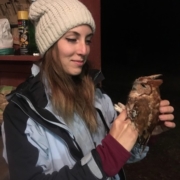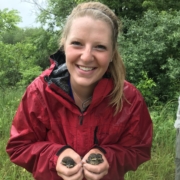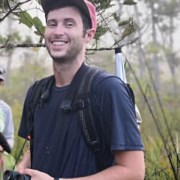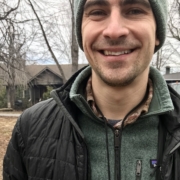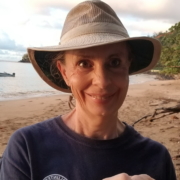The Kauaʻi Forest Bird Recovery Project has assembled an incredible new crew. All recently-hired staff have properly quarantined and are ready to attack an exciting new project involving forest birds and mosquitoes.
Joining us in the last few months and in no particular order are:
Kim Shoback, our Americorps Kupu Service Member, joined KFBRP in the fall of 2019 after a whirlwind of field research jobs in the Dominican Republic, Costa Rica, and North Carolina.
Kara Winter, one of our two new Field Assistants, came to us in March of 2020. With a dual degree in Biology and Natural Resources from Northland College, she has held several jobs observing and banding birds all over the country and abroad.
Bow Tyler recently joined KFBRP from the Pacific Northwest. Bow has a self proclaimed “mild obsession” with birds and will also work as a Field Assistant.
Roy Gilb is our new GIS and Database Management Assistant. Roy grew up in the hills Virginia where he spent as much time as possible outdoors in the Blue Ridge Mountains.
Monika Mira is a long-time Kauai resident who came to KFBRP to help us lay out and publish our children’s books. She now maintains our website and blog and helps develop new outreach materials.
Jenny Allen joined KFBRP in May of 2020 to provide fiscal and program support. Australian by birth and a veterinary graduate from the University of Sydney, Jenny moved to Kauaʻi in 2010. Her passion for native plants and conservation on Kauaʻi is evidenced by her work with the National Tropical Botanical Gardens, Princeville Botanical Garden, the Kauai Invasive Species Committee, and the Hanalei National Wildlife Refuge.
Project Overview
The project that these new “eco warriors” will be working on is a study that will support the development of landscape-level suppression of mosquito populations to halt avian declines and protect human health.
Here is a simplified version of the problem and project. A more detailed explanation can be found directly below. Climate change increases the range and distribution of mosquitoes. Mosquitoes carry diseases that cause bird populations to decline. Our staff is tasked with a.) learning more about mosquito populations in bird habitat, b.) locally controlling some of these populations, c.) screening birds for disease, and d.) sharing information about new mosquito suppression techniques.
Project Details
Climate-driven changes to precipitation and hydrology may have altered the density and permanence of larval habitat, thus increasing distribution and abundance of mosquitoes in high-elevation forest bird habitat that was once mosquito-free.
Of particular interest are two species of mosquitoes, Culex quinquefasciatus, a vector for avian diseases and Aedes japonicus, an important potential vector of both human and avian diseases. Kauaʻi’s Forest birds are extremely susceptible to diseases like avian malaria which they have little or no natural immunity. Endemic bird populations are crashing due to the spread of this disease.
Without concerted action to control these vectors, the demise of several forest bird species is imminent, and a surge in human diseases possible.
The birds themselves are responsible for ecosystem-wide services like the dispersal of seeds to perpetuate the existence of the native forest, which in turn captures and filters rain water that fills aquifers and runs through our streams. This is how the far-reaching arms of climate change can cause a cascade of events that affects the smallest forest bird to the water that you drink.
Please join us in welcoming our new staff members and wish them luck in their endeavors to better understand mosquito populations on the Alakaʻi Plateau, spatial overlap of diseased birds and mosquitoes, locally control existing mosquito populations, screen bird populations for disease prevalence, and promote understanding among local people of threats of mosquito-borne diseases to endangered forest birds and human health. This new project will lay the groundwork for the application of mosquito suppression using the Incompatible Insect Technique (ITT). Stay tuned to learn more about ITT or watch the video below.

